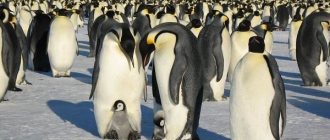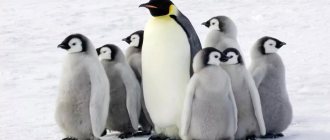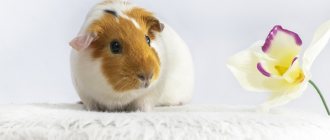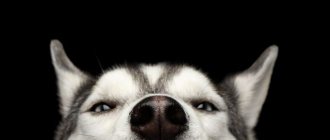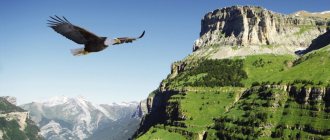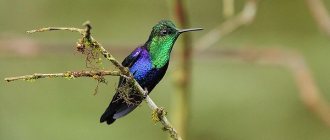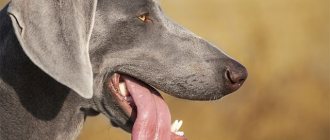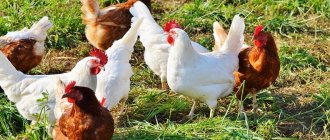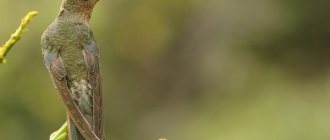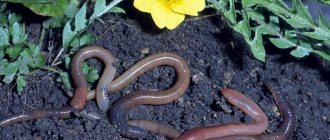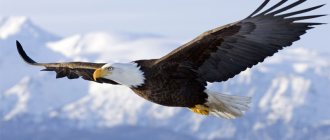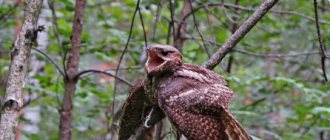Penguin anatomy
The body of penguins has a streamlined shape. This body shape is very comfortable when swimming in water. The entire body is covered with waterproof feathers, which are arranged very tightly and protect the penguin from wetness and winds. The penguin has two wings, which under water look more like two propellers. The penguin walks on two short and thick legs and its tail also serves as support. The bird's tail is very hard, consisting of 17-20 not very long feathers. Unlike other birds, the penguin stays strictly vertical on land. Penguins' beaks are very sharp and strong. In order for the penguin to be comfortable in the cold areas of the planet, it has a 2-3 centimeter layer of fat under its skin. Penguins' eyes are well adapted for diving, but on land the bird becomes nearsighted.
The size of penguins varies depending on their species. For example, the largest Emperor penguin can reach a height of 120-130 centimeters and weigh up to 40 kg, and the smallest species of penguin, the Lesser penguin, can reach a height of up to 40 cm and a body weight of up to 1 kg. All penguins have approximately the same coloring - dark back and white belly. Penguins molt once a year. During molting, the penguin becomes “shaggy”. During this period, the penguin is on land and does not eat anything.
MAGAZINE Preschooler.RF
Educational and research project “Where do penguins live”Problem
It all started when Darik said that he loved the cartoon "Penguins of Madagascar" . In the cartoon, the story begins in Antarctica. But when I asked where the Penguins live, Darik replied that they live in the North. To the question of where Antarctica and Madagascar are located, no one answered correctly either.
Goals and objectives
Goal: development of cognitive-experimental activities and creative activity of children through the use of modern pedagogical technologies “Travel on the map” .
Tasks:
- develop cognitive and creative activity in the process of various types of activities;
- give children an idea of the southern continent “Antarctica” , its features, enrich children’s knowledge about the animals of Antarctica; stimulate the development of children's speech, enrich their vocabulary;
- cultivate a caring attitude towards the environment;
- Maintain interest in peer activities.
- Cultivate kindness towards each other.
Planning with children
- Three Question Model
- System web of the project
- Algorithm for traveling on a map
- Selecting a destination.
- Determining the route on the map.
Making assumptions about who and what we might meet, what we need to take with us on a trip.
The journey itself. Cognitive and research activities.
Summing up, checking assumptions, what new things have been learned.
Materials for “Travel on the Map”
- Globe, physical map of the world, contour maps for each child.
- Illustrations of types of transport.
- Cards or photo illustrations depicting natural landscapes of different Antarctica;
- Cards depicting typical representatives of flora and fauna from different parts of the world (demonstration material).
- Small tag cards for sticking on the map along the route
- Fiction
- materials for children's research (experiments, experimentation).
Decorating the flag of Antarctica
NOD "Who lives in Antarctica?"
Books on the topic of the project
REMP
Cards for independent work developed by defectologist I.M. Yurchenko.
Experiments with ice
Experimenting with jelly
Cards for independent work developed by I.M. Yurchenko.
- We sculpt animals of Antarctica
- Application “Penguins on ice floes”
- Penguins made from waste material
- Crafts with parents
- Finger Theater "Three Penguins"
Cinema screening of a scientific film for children “The Emperor Penguin” BBC
Playing board games
Creation
- Creating a model of Antarctica
- Decorating the music room before the game
- Final event Game-quest “Expedition to the South Pole”
- Game massage “Protective cream”
- Musical game “The sea is agitated...”
Final event Game-quest “Expedition to the South Pole”
Motivation "Penguin Lost Egg"
Challenges "Crossing the ice tunnel and abyss"
Final event Game-quest “Expedition to the South Pole”
Meeting with a polar explorer
Tests “What do you know about penguins?”
Final event Game-quest “Expedition to the South Pole”
Dog sledding
Challenges "Get the seagull"
Final event Game-quest “Expedition to the South Pole”
Logori
Test “Guess the riddles of the seagull”
Final event Game-quest “Expedition to the South Pole”
"Feed the Seal" Challenge
Challenge "Decipher the task"
Final event Game-quest “Expedition to the South Pole”
Puzzle Challenge
Challenge “Cross the Ice Floes”
Final event Game-quest “Expedition to the South Pole”
Outdoor game “Seals and Killer Whale”
Final event Game-quest “Expedition to the South Pole”
Come up with a name for the little penguin
Game "Warm the Egg"
Final event Game-quest “Expedition to the South Pole”
Outdoor game “How penguins carry eggs”
Dance of the little penguins"
Photo for memory
Tree of knowledge
Project results
Literature
- Mikhailova-Svirskaya L.V. The project method in the educational work of kindergarten. Enlightenment, 2015
- Mikhailova-Svirskaya L.V. Individualization of education for preschool children. A manual for preschool teachers. Federal State Educational Institution Education, 2015
All personal data is posted with the consent of the subject(s) to the processing of personal data
| Next > |
Penguin lifestyle
Penguins are excellent swimmers. They can dive to depths from 3 to 130 meters. Sometimes it’s simply huge distances to overcome (more than 20 km). Penguins can reach speeds in water of up to 10 km/h. And at a time when they are not concerned about offspring, they can go into the open sea 1000 km from the coast.
If the penguin needs to move on land, then he has an interesting way. It lies on its belly, pushes off with its paws and slides along the snow or ice. With this method of movement, penguins can reach speeds of up to 7 km/h.
Penguins live in groups. You could even say colonies. On the shore, they unite in flocks, the number of which can reach tens and hundreds of thousands of individuals.
Why don't my paws get cold?
In general, a penguin just needs to sit down to keep its feet warm among the feathers. However, your feet will still touch ice or snow. Why don't they freeze, since penguins can stand on cold surfaces for hours? At the same time, they do not demonstrate any discomfort from what is happening.
To provide this part of the body with such amazing resistance to cold, nature has created a completely special system of temperature exchange. The circulatory system of the paws has a specific structure; the flows of venous and arterial blood are adjacent here, and temperature exchange occurs between them.
Penguin circulatory system
Due to the fact that the veins with cold blood rising from the paws pass almost in contact with the arteries supplying hot blood, the temperature is averaged. And the penguins’ feet turn out to be, of course, not as hot as the rest of the body, but not cold either.
Penguin breeding
These birds, like Swans and the Mandarin Duck, are monogamous birds. This means that the couple is chosen alone and for life.
Sexual maturity is reached at different ages in different species of penguins, but not before the penguin is 2 years old, and in Golden-haired penguins sexual maturity is generally reached at the age of five years. The male, trying to attract the attention of the female, begins to make very loud sounds that are similar to the sound of a trumpet.
Penguins choose a nest site on the shore or in rock recesses. The nest is made from pebbles and plants. The female can lay up to 3 eggs at a time. But three is very rare. Most often there is one egg that is white or greenish in color. Both take a role in incubating the eggs. Since the parents need to eat, they take turns to hunt.
The parents incubate the eggs for up to 100 days (here it all depends on the type of penguin). The shortest incubation period is 30 days. The chicks hatch blind and with very thick plumage. Until the chick molts and has feathers like its parents, it does not enter the water. And he is constantly on land. After two weeks, the penguin chick can already see fully. For about three weeks, the female and male do not leave their offspring. And then they leave their children, only occasionally bringing them food. The chicks begin to form groups that people call nurseries. On average, only half of the chicks survive.
Interesting Facts
1. Penguins can travel very long distances, about hundreds of kilometers. The sun tells them the right path; when the sun disappears behind the clouds, the penguins can get lost. 2. Being in the water column, the penguin makes practically no sounds, but it “talks” a lot to other penguins when they find themselves on land. 3. The penguin is the only bird that can swim and walk standing, but cannot fly.
All answers to workbooks on the world around us, detailed analysis of complex tasks here
Hello! My name is Maria, I am the author of the Pushkin website. I hope that my site helps you, in turn I ask for your help. My son was diagnosed with autism. He needs daily correctional activities, if you can help, I will be grateful to you. Every 10 rubles you give is another chance for my child to live a full life. Collection page here
Let's learn to draw together
One of the simplest examples of painted birds is the penguin, whose silhouette when executed resembles a pear.
After preliminary preparation (choosing a workplace, selecting the necessary tools and familiarizing yourself with the sketch), you should begin to engage in creativity:
- In the center of the sheet, using a simple pencil, draw the outline of a penguin, in the shape of a pear.
- Add wings to the sides.
- The oval tummy should be drawn closer to the bottom of the silhouette, where the paws should peek out.
- Paws – two limbs at the bottom of the chick. In nature, these are three webbed fingers, but for a child's drawing, legs in the form of flippers are suitable.
- The penultimate step in completing the picture will be to draw the eyes at the top of the pear-like figure - two circles, in the center with eyes, as well as a teardrop-shaped beak.
- The final stage is coloring. The color of the penguin is not complicated, so black will be enough for the entire body, and red for the legs and beak. You don’t have to paint over the belly – it’s already white.
plump chick
The next, no less complex, but quite cute penguin, will also be within the power of even a little artist. The technique and order of performing the elements is different, but this does not affect the difficulty:
- The drawing should begin with the image of the eyes - two small circles in the center of the sheet. Then you need to add pupils, making small dots on a black background - highlights.
- The line of the beak is two semicircles: one larger is the upper part, the second smaller is the lower.
- Above the eyes, to the line of the beak, we draw a semicircle - the upper part of the head, and then we draw a line of the lower semicircle, but it should be larger than the first, so that in general we get a muzzle with chubby cheeks.
- To complete the head, you should add two arches above the eyes, they will create clear boundaries of the black and white color of the penguin.
- The body is two ovals, one of which is in the center of the other, and the smaller one is the white belly.
- There are two wings on the tanks - triangles.
- At the bottom of the body there are two legs, conventionally divided into three fingers.
- At the end you need to add a few but bright colors in the form of black and yellow. If you paint the drawing with water-based paints, you will also need a white tint for the tummy and cheeks.
What do penguins eat in the wild?
The basis of penguins' diet consists of fish, crustaceans and plankton, as well as some representatives of cephalopods. Penguins love to eat anchovies, krill, sardines, squid and octopus, which are small in size. When penguins hunt, they can dive into the water thousands of times in search of prey. The number of dives depends on the available climatic conditions, the characteristics of the penguin species and the availability of food.
Penguins mainly drink salty sea water. When eating, penguins suck prey into their mouths along with a small amount of water. Because of this, there is an excess of salt in them, which is excreted by special glands located above the eyes.
Penguins can swim in sea water for about 30 km in search of prey. These birds can hunt at a depth of more than 3 meters for 1.5 hours.
See also: Kite
Painting design options
It is clear that the penguin is the main character on the sheet, but in order for the drawing not to be boring and monotonous, it is advisable to supplement it with other elements, so that upon completion of the work it can be called a full-fledged painting.
One option would be:
- falling snow against the background of a cheerful bird;
- penguin on a floating ice floe;
- penguin with a scarf and warm headphones;
- blue iceberg in the distance.
All this does not require special skills and innate talent for drawing; the only condition will be the mandatory use of a simple pencil and an eraser to erase unnecessary details or erase unsuccessful lines. And coloring will bring a lot of pleasure, because from a black and white drawing and the same animal you can get an incredibly bright, cute and positive picture.
